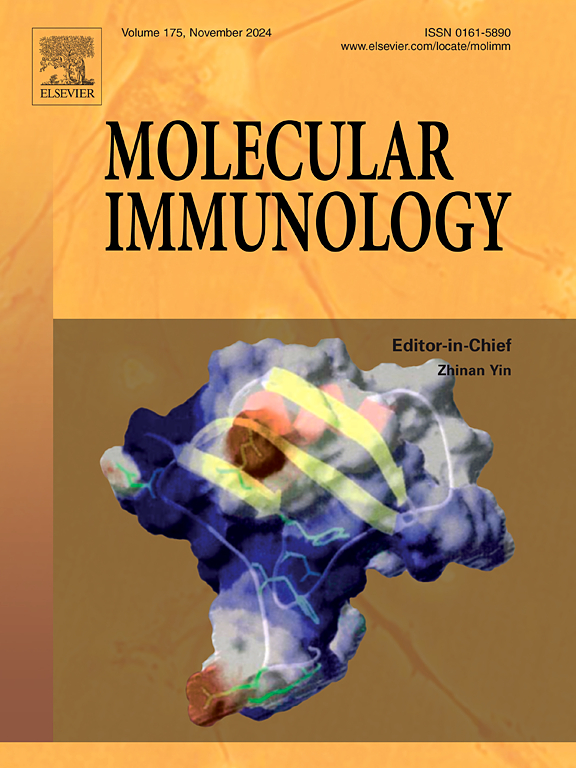CD137可能是甲状腺功能亢进症中Th1/ th17驱动的自身免疫和b细胞亢进的关键调节因子
IF 3.2
3区 医学
Q2 BIOCHEMISTRY & MOLECULAR BIOLOGY
引用次数: 0
摘要
目的探讨抗甲状腺药物(ATD)干预对甲状腺功能亢进患者血浆细胞因子、趋化因子和外周血单个核细胞(PBMCs)中CD137、IFN-γ和IL-17表达水平的影响。目的是阐明Th细胞免疫平衡以及细胞和体液免疫在甲亢发病机制中的作用。方法在2021年4月至2022年4月期间诊断的81例甲状腺功能亢进患者最初纳入研究。25例患者接受抗甲状腺药物(ATD)治疗,随后分为干预后组,平均治疗时间为129.84天。此外,83名健康个体作为对照。采用液相微阵列技术、酶联免疫吸附试验(ELISA)和流式细胞术技术检测血浆细胞因子浓度、可溶性CD137 (sCD137)水平以及T淋巴细胞和B淋巴细胞上CD137的表达。与正常对照组相比,干预前组外周血浆中IFN-γ、TNF-α、IL-7、IL-8、IL-17A、MCP-1、MIP-1β和IL-10水平升高。ATD干预后,与正常对照组相比,干预后组外周血IL-1β、TNF-α、IL-4和MIP-1β水平升高。干预前组TNF-α、MCP-1、IL-13、IL-10水平高于干预后组(P <; 0.05)。2. 干预前组外周血单个核细胞(PBMCs)中CD19 + B细胞的百分比高于正常对照组(P <; 0.05)。3. CD4细胞的百分比 + CD137 + T细胞CD8 + CD137 + T细胞,和CD19 + CD137 + B细胞在PBMCs干预前组比正常对照组(P & lt; 0.05)。4. 干预前组外周血浆sCD137浓度高于正常对照组(P <; 0.05)。5. 干预前组受刺激PBMCs中CD4 + T细胞分泌IFN-γ和IL-17A水平,以及CD8 + T细胞分泌IFN-γ水平均高于正常对照组(P <; 0.05)。结论甲状腺机能亢进以免疫失调为特征,表现为Th1/Th2/Th17细胞因子表达改变和CD137活性升高。CD137是一种有前景的免疫功能生物标志物和潜在的治疗靶点。本文章由计算机程序翻译,如有差异,请以英文原文为准。
CD137 might be a pivotal regulator of Th1/Th17-driven autoimmunity and B-cell hyperactivity in hyperthyroidism
Objective
This study aims to investigate the impact of antithyroid drug (ATD) intervention on the expression levels of CD137, IFN-γ, and IL-17 in plasma cytokines, chemokines, and peripheral blood mononuclear cells (PBMCs) of hyperthyroid patients, compared to healthy controls. The goal is to elucidate the involvement of Th cell immune balance, as well as cellular and humoral immunity, in the pathogenesis of hyperthyroidism.
Methods
Eighty-one hyperthyroidism patients diagnosed between April 2021 and April 2022 were initially included in the study. Twenty-five patients underwent antithyroid drug (ATD) therapy and were subsequently categorized into the post-intervention group, with an average treatment duration of 129.84 days. Moreover, eighty-three healthy individuals were enlisted as controls. Plasma cytokine concentrations, soluble CD137 (sCD137) levels, and CD137 expression on T and B lymphocytes were evaluated through liquid-phase microarrays, enzyme-linked immunosorbent assay (ELISA), and flow cytometry techniques.
Results
1. Compared to the normal control group, the pre-intervention group exhibited elevated peripheral plasma levels of IFN-γ, TNF-α, IL-7, IL-8, IL-17A, MCP-1, MIP-1β, and IL-10. Following ATD intervention, the post-intervention group showed increased peripheral plasma levels of IL-1β, TNF-α, IL-4, and MIP-1β relative to the normal control group. Furthermore, levels of TNF-α, MCP-1, IL-13, and IL-10 were higher in the pre-intervention group than in the post-intervention group (P < 0.05). 2. The percentage of CD19 + B cells in peripheral blood mononuclear cells (PBMCs) was higher in the pre-intervention group than in the normal control group (P < 0.05). 3. The percentages of CD4 +CD137 + T cells, CD8 +CD137 + T cells, and CD19 +CD137 + B cells in PBMCs were greater in the pre-intervention group than in the normal control group (P < 0.05). 4. The concentration of sCD137 in peripheral plasma was higher in the pre-intervention group than in the normal control group (P < 0.05). 5. Levels of IFN-γ and IL-17A secretion by CD4 + T cells, as well as IFN-γ secretion by CD8 + T cells in stimulated PBMCs, were higher in the pre-intervention group than in the normal control group (P < 0.05).
Conclusion
Hyperthyroidism is marked by immune dysregulation, evident in altered Th1/Th2/Th17 cytokine expression and elevated CD137 activity. CD137 emerges as a promising biomarker for immune function and a potential therapeutic target.
求助全文
通过发布文献求助,成功后即可免费获取论文全文。
去求助
来源期刊

Molecular immunology
医学-免疫学
CiteScore
6.90
自引率
2.80%
发文量
324
审稿时长
50 days
期刊介绍:
Molecular Immunology publishes original articles, reviews and commentaries on all areas of immunology, with a particular focus on description of cellular, biochemical or genetic mechanisms underlying immunological phenomena. Studies on all model organisms, from invertebrates to humans, are suitable. Examples include, but are not restricted to:
Infection, autoimmunity, transplantation, immunodeficiencies, inflammation and tumor immunology
Mechanisms of induction, regulation and termination of innate and adaptive immunity
Intercellular communication, cooperation and regulation
Intracellular mechanisms of immunity (endocytosis, protein trafficking, pathogen recognition, antigen presentation, etc)
Mechanisms of action of the cells and molecules of the immune system
Structural analysis
Development of the immune system
Comparative immunology and evolution of the immune system
"Omics" studies and bioinformatics
Vaccines, biotechnology and therapeutic manipulation of the immune system (therapeutic antibodies, cytokines, cellular therapies, etc)
Technical developments.
 求助内容:
求助内容: 应助结果提醒方式:
应助结果提醒方式:


